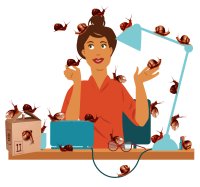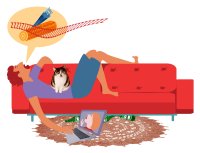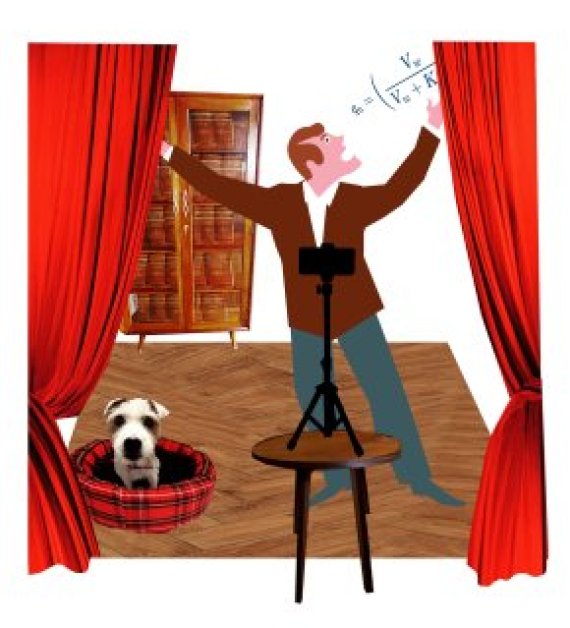Text Roelof Kleis Illustration Yvonne Kroese
Not the sort of package that comes in the post every day: two weeks ago, students on the Animal Ecology Master’s course received a box of 10 snails, temporarily housed in the kind of tub kebabs come in. Vineyard snails of different sizes so the students could conduct some grazing experiments at home. The packages came from Ignas Heitkönig, who teaches Wildlife Ecology & Conservation. He ordered 1700 of them from a supplier in Brabant. Normally, that component of the Master’s course takes place at the Nergena experimental farm in the Binnenveld near the campus. And the test subjects are not snails but cows, horses, sheep and rabbits. Students work in groups and apply the theory and modelling methods they have learned about in the previous weeks. ‘Students love being out in the field together working with the animals,’ says Heitkönig. ‘They think fieldwork is great!’
But they can’t do it while the coronavirus crisis lasts, so Heitkönig and his team came up with the snail option. ‘Students have to build a little stadium of 50 by 50 centimetres with various obstacles dotted around it. We’ve put knowledge clips online explaining how to look after and feed the snails. The idea is for them to record what they eat, how fast they move, and that sort of thing. You can test all kinds of theory-based questions in a stadium like that.’

Everyday chemistry
Hendra Willemen, who teaches Organic Chemistry, had to put the first-year course Bio-Organic Chemistry for the Life Sciences online from one day to the next at the beginning of period five. ‘You could do the theoretical component online all right,’ she says, looking back. ‘But you can’t do a chemistry practical online.’ Not until she realized that a kitchen is a kind of lab too. ‘A lot of chemistry goes on in the kitchen. When you make coffee you are using extraction and filtration processes. And you can do a lot with common or garden substances such as soda, washing-up liquid or vinegar. It’s not high-level chemistry, but there are things you can demonstrate.’
So together with her colleagues, Willemen thought up a large number of little experiments to do at home. Make a whole litre of tea with one teabag, for instance. Do it again, but this time use 250 ml water four times in a row. Combine these four portions of tea and compare the result with that first litre. Which tea is darker, and why? A page was created online for describing the experiments, uploading photos of the homework, and discussing it.
You can do chemistry experiments at home with soda, washing-up liquid and vinegar
Just like Willemen, Sjoerd Brandsma and his colleagues at Landscape Architecture and Spatial Planning faced the task of teaching a highly practical course like Studio Regional Design online. ‘This course is very intensive and important for our chair group,’ explains Brandsma. ‘The system is that students first analyse a landscape together in groups, and then, after being taught some theory, work individually on an assignment to design a location. The task might be about dealing with drought, for instance, or developing nature. In this case, the area in question was Het Groene Woud, a nature area between Eindhoven, Breda and Tilburg.’
On excursions to the area, the students learn how to analyse it and to read a landscape. But that wasn’t possible this time. Brandsma: ‘To enable them to get to know the area anyway, we asked students from previous years to share photos. We also made videos of the area available, and we explained in more detail what the landscape is like.’
The actual design process took place on online platforms where students could work and consult each other in groups of six. The studio took the form of a digital noticeboard on which students could put whatever they wanted and where they could see each other’s work.

Lack of contact
Brandsma is quite satisfied with the alternative way of teaching the course that the team came up with. ‘First of all because we kept all the students on board. This is one of the toughest courses in our programme. We managed to have something to offer them without lowering the bar. So the learning goals were reached. But I don’t think this is really a teaching method that works for our subject. The students were very understanding, and they thought it was great that we managed all this in such a short time. But there is a lack of direct contact. Normally, you can see when someone is getting stuck and you can work with them. You brainstorm and you sketch, and you get somewhere. To become a good designer, you need an experienced designer to look over your shoulder. That aspect of design education is missing from this version of it.’
The sense of a lack of contact that Brandsma describes is shared by nearly all the teachers. Research by Tim Stevens (Education and Learning Sciences) on the transition from classroom to online education also highlights the lack of direct, personal contact with students as a major disadvantage of online teaching. Stevens did a survey amongst a large number of teachers after the end of period five, asking them about their first experience of teaching online. The majority of the teachers think teaching online has a negative effect on the learning process. It compares badly with face-to-face teaching in terms of the students’ motivation and involvement, the interaction between students, and the feedback they get from teachers.
The transition to online has made me more creative. But is it nice? No
It’s not easy giving feedback online. Stevens thinks teachers do not make much use of the available online options for giving feedback. ‘Only 15 per cent of the teachers use tools like FeedbackFruits, quizzes and rubrics. Sometimes the reason is that they had to make the switch so fast. Giving feedback takes a lot of preparation. I’m interested to see whether those tools will be used more in the coming periods, now that teachers are better prepared.’ But interestingly, in the course evaluations that students fill in at the end of every course, they don’t report missing the feedback at all. Students are satisfied with the interaction with the teachers. Stevens comments: ‘The teachers are comparing online with traditional teaching, whereas the students were responding in a course evaluation. That’s not the same thing. It may be that students have borne in mind the context in which the course was given. In which case, they meant: under the circumstances, I am satisfied. So we are going to conduct another survey amongst students, asking them the same question we asked the teachers: do you feel the learning process goes better online or in the classroom?’
Job satisfaction
The lack of direct content also has an impact on the teachers’ job satisfaction. About 60 per cent of the teachers say they don’t like teaching online, shows Stevens’ study. ‘No,’ says Katja Teerds (Human and Animal Physiology) categorically, when asked whether teaching online is nice. ‘I sorely miss the interaction with the students.’ She was involved in three courses during period five, including her ‘own’ Master’s course Brains, Hormones and Metabolism. ‘We heard on the Friday that everything had to be online by Monday.’ All the lectures had to be recorded. ‘We didn’t have anything on video, because I was never a great fan of that. I like the direct contact with the students much too much for that.’ The tutorials went online on Brightspace, and a virtual classroom was set up on a fairly regular basis to provide extra contact moments. But that is no substitute for real contact. ‘When you teach a class the normal way, you can see what’s going on in a group. You can gauge the group,’ says Teerds. ‘That is missing now. On the basis of my experience, I know which part of the material students find difficult, and I pay extra attention to that, but online you hardly get any questions.’
Because of the isolation, students rely more on their own perceptions and skills
It still works, though. ‘Amazingly well, in fact,’ says Teerds. ‘For the tutorials I have asked the students to upload their answers to the questions a day ahead. Then I make a PowerPoint presentation with the answers, and I go over them online. And guess what? The students’ answers were far more extensive than they were in tutorials in the past. The students worked on the material far more intensively.’ Teerds had the same experience with the online histology practical that she now gives during period six. The students don’t get to peer through a microscope this time. Instead, they study microscope images on a cd-rom at home. Teerds: ‘They used to use those images as a sort of reference point alongside their microscope. Now they work with them in a very different way. Much more intensively.’ She can explain that. ‘In the classroom there are six of you around a table, and two people to one microscope. So if one student isn’t in the mood, it affects the others. Students influence each other’s behaviour. Now they are on their own at home without those distractions.’

Work pressure
Brandsma has had the same experience in his design studio. ‘Because students are working more in isolation, they focus better. They are not distracted by each other. The isolation makes students rely much more on their own perceptions and skills. I find that very striking and nice to see. In their own rooms they are not distracted and influenced by what the others are up to. And you get a greater diversity in what they make, which is good to see. We should try to make use of this experience after the coronavirus crisis is over.’
Hendra Willemen looks back on her kitchen experiments with pleasure. ‘They gave me some positive energy. But they certainly aren’t a good substitute for working in a real lab. You can’t acquire the same practical skills as you can in a lab. In that sense, certain learning goals are not being reached. The context is different. An extractor fan is not a fume hood, and a glass jar is not a conical flask.’ Giving a lecture online is not nice either. ‘You are talking into a bit of a vacuum. You don’t know whether your students can follow you, and you don’t get any questions. Under the circumstances, it was acceptable, but you can’t always teach like that. After the summer vacation we shall teach this course again. Luckily we can then give part of the practical on campus. I’m pleased about that. We really want to go back to the teaching lab.’
You are talking into a bit of a vacuum. You don’t know if they can follow you and you don’t get any questions
‘I throw myself into it, and it is challenging,’ says Heitkönig. ‘I don’t want to blow my own trumpet, but in the first few weeks I was working 16 hours a day, at the expense of my sleep. It gave me sleepless nights. What should we do with the foreign students, for instance? We couldn’t post snails to them. They had to find their own snails, and that is not easy. Just yesterday evening I got an email from Chile: It is winter here and there are no snails to be found. And anyway, there is a lockdown and I’m not allowed outside.’
It gave me sleepless nights
The extra work pressure for teachers is reflected in Stevens’ research findings too. Two out of three teachers are experiencing more stress due to teaching online. And four out of five are working longer hours. ‘The transition to online has made me more creative and I get ideas for conveying information in new ways,’ says Heitkönig. ‘But do I like it? No, a resounding no! I miss the direct contact on all fronts, being able to look each other in the eye. But funnily enough, the learning goals are not in danger. We think we have covered them all by this method. The only question is whether every individual student will actually achieve the goals. It’s hard to give a grade for group work if you have no idea what went on in the groups. We have to manage with what we hear about it. That’s not at all credible, educationally speaking.’


